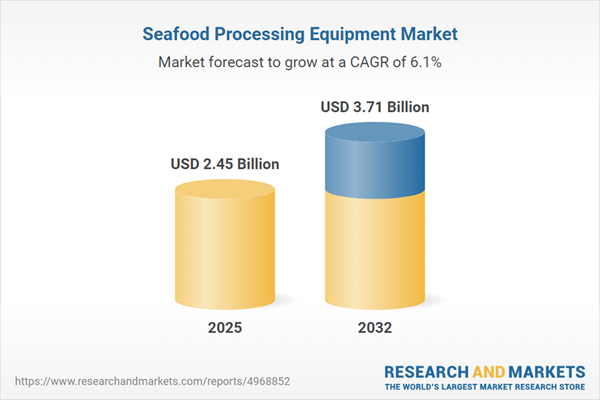Speak directly to the analyst to clarify any post sales queries you may have.
The seafood processing equipment market is evolving rapidly as global seafood demand and stringent food safety regulations reshape investment priorities. Industry leaders must understand shifting trends, technology integration, and market dynamics to unlock sustainable growth in this competitive landscape.
Market Snapshot: Seafood Processing Equipment Market Growth and Outlook
The Seafood Processing Equipment Market grew from USD 2.31 billion in 2024 to USD 2.45 billion in 2025, and is projected to sustain a CAGR of 6.07% through 2032, achieving a value of USD 3.71 billion. This growth is fueled by rising global seafood consumption, increasing demand for sustainable processing solutions, and continued advances in automation and digital integration. Senior decision-makers focused on operational efficiency and regulatory compliance are actively investing in technology-driven upgrades for their processing infrastructure.
Scope & Segmentation
This report comprehensively analyzes the following areas to provide actionable insights for leaders evaluating market entry and expansion strategies:
- Equipment Types: Cutting equipment, filleting equipment, freezing equipment, packaging equipment, peeling equipment, sorting equipment, washing equipment.
- Technologies: Automated systems, semi-automated solutions, manual platforms.
- Operational Capacity: Large-scale, medium-scale, and small-scale production facilities.
- Applications: Crustacean processing, fish processing, mollusk processing, shrimp processing.
- End Users: Research institutes (academic and government labs), seafood processing plants (artisanal and industrial facilities).
- Regions: Americas, Europe, Middle East & Africa (EMEA), Asia-Pacific—covering subregions such as North America, Latin America, Europe, Middle East, Africa, and key Asia-Pacific economies.
- Leading Companies: GEA Group AG, HABUR-SAWS GmbH, JBT Corporation, Kroma A/S, Luohe Quality Mechanical Equipment Co., Ltd, MTC Food Equipment, Inc., Pisces Fish Machinery, Inc., Polar Systems Ltd., Seafood Technology Limited, Uni-Food Technic A/S, Zhengda Food Machinery Co., Ltd., Zhucheng Bokang machinery Co., Ltd., Middleby Corporation, Charoen Pokphand Foods Plc., Leroy Seafood Group ASA, Cooke Inc., High Liner Foods Inc., Marlen International by Duravant LLC, DSI DANTECH A/S, Martak, LTD.
Key Takeaways for Senior Decision-Makers
- Adoption of automation, including robotics and real-time monitoring, is redefining productivity and food safety standards.
- Sustainability-focused innovations, such as energy-efficient freezing and biodegradable packaging, address both regulatory pressures and consumer expectations.
- Customization and modularity are unlocking flexibility for small and medium processors, enabling phased investments as demand evolves.
- Strategic alliances and acquisitions accelerate access to emerging markets, strengthen product portfolios, and support rapid localization.
- Regional policy frameworks and free trade agreements present both opportunities and challenges, making scenario planning and supply chain agility essential.
- Cross-functional workforce training will be a critical enabler for maximizing the benefits of semi-automated and automated platforms.
Tariff Impact: Navigating United States Tariffs in 2025
Recent United States tariffs on imported seafood processing equipment components are prompting companies to diversify their sourcing strategies and renegotiate vendor agreements. The heightened cost pressure is driving manufacturers to localize supply chains and increase collaboration with trade associations to advocate for regulatory clarifications. Strategic scenario planning has become vital for managing budgetary risks and procurement timelines in this shifting policy environment.
Methodology & Data Sources
This report draws on a multiphase research methodology, including extensive secondary research from patent filings, trade publications, regulatory documents, and academic sources. Analysts conducted primary interviews with C-suite executives, operations managers, and technical experts from equipment suppliers and processing plants. Data triangulation and cross-segmentation mapping ensure the reliability and relevance of insights, with coverage spanning Americas, EMEA, and Asia-Pacific regions.
Why This Seafood Processing Equipment Market Report Matters
- Equips executives with market-driven strategies tailored to evolving technological, regulatory, and regional dynamics in seafood processing.
- Supports informed capital allocation by illuminating growth drivers across applications, segments, and operational capacities.
- Provides competitive intelligence on leading manufacturers and highlights the impact of geopolitical and policy changes on supply chains.
Conclusion
This report delivers a robust framework for informed strategic planning as automation, sustainability, and market complexity reshape the seafood processing equipment landscape. Leaders prepared to act on these insights will secure long-term operational resilience and market advantage.
Additional Product Information:
- Purchase of this report includes 1 year online access with quarterly updates.
- This report can be updated on request. Please contact our Customer Experience team using the Ask a Question widget on our website.
Table of Contents
3. Executive Summary
4. Market Overview
7. Cumulative Impact of Artificial Intelligence 2025
Companies Mentioned
The companies profiled in this Seafood Processing Equipment market report include:- GEA Group AG
- HABUR-SAWS GmbH
- JBT Corporation
- Kroma A/S
- Luohe Quality Mechanical Equipment Co., Ltd
- MTC Food Equipment, Inc.
- Pisces Fish Machinery, Inc.
- Polar Systems Ltd.
- Seafood Technology Limited
- Uni-Food Technic A/S
- Zhengda Food Machinery Co., Ltd.
- Zhucheng Bokang machinery Co., Ltd.
- Middleby Corporation
- Charoen Pokphand Foods Plc.
- Leroy Seafood Group ASA
- Cooke Inc.
- High Liner Foods Inc.
- Marlen International by Duravant LLC
- DSI DANTECH A/S
- Martak, LTD
Table Information
| Report Attribute | Details |
|---|---|
| No. of Pages | 191 |
| Published | October 2025 |
| Forecast Period | 2025 - 2032 |
| Estimated Market Value ( USD | $ 2.45 Billion |
| Forecasted Market Value ( USD | $ 3.71 Billion |
| Compound Annual Growth Rate | 6.0% |
| Regions Covered | Global |
| No. of Companies Mentioned | 21 |









